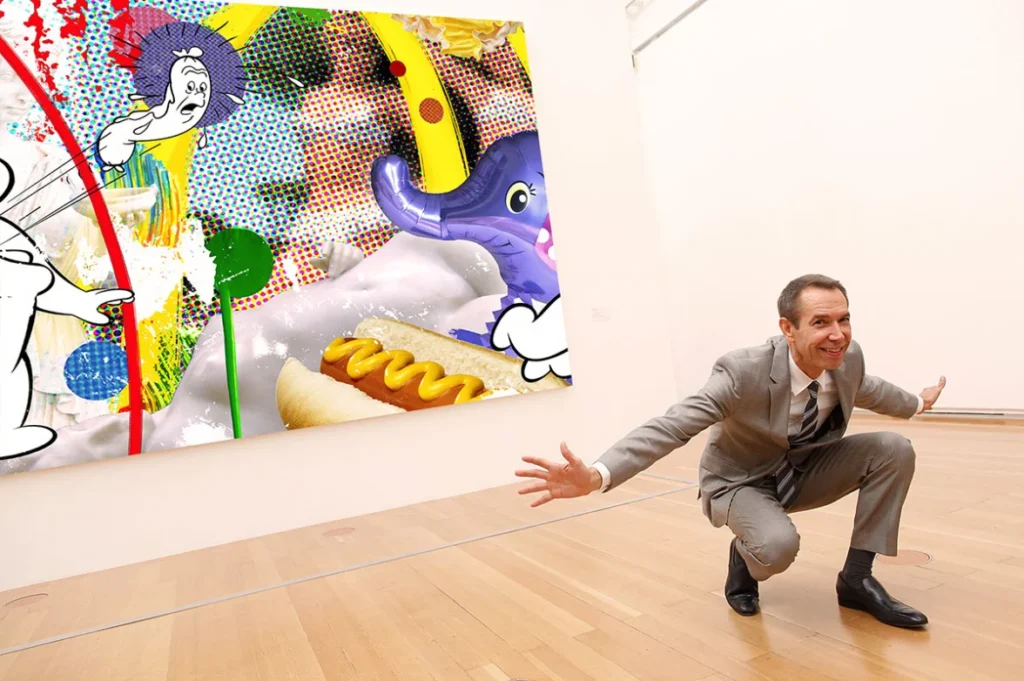The art world has witnessed countless visionaries and mavericks, but few have left as indelible a mark as Jeff Koons. Born in York, Pennsylvania, in 1955, Koons has become a household name in contemporary art. His journey from a modest background to international acclaim is nothing short of a modern artistic odyssey.
Koons’ fascination with art began at a young age. After studying at the Art Institute of Chicago and the Maryland Institute College of Art, he relocated to New York City in the late 1970s, where he found inspiration in the thriving art scene. Here, Koons began crafting his unique artistic identity, which would captivate the art world and transcend the boundaries of traditional artistic norms.
What sets Koons apart is his unparalleled ability to fuse the realms of artistry and market dynamics. He is not just an artist; he is a maestro at understanding the intricacies of the art market, a trait that has earned him a unique position in the world of contemporary art.
Koons’ artworks are characterized by their distinctiveness, often blurring the lines between high and low culture. His works have been described as “neo-pop,” which signifies his commitment to exploring the boundary between popular culture and fine art. From inflatable toys to stainless steel balloon animals, Koons has redefined art in a way that provokes, challenges and delights his audiences.
The Fusion of Artistry and Market Dynamics
At the heart of Koons’ remarkable career is a profound understanding of the interplay between art and commerce. His ability to create pieces that resonate with the art connoisseur and the investor has established him as a driving force in the art market.
Koons’ iconic “Balloon Dog” is a quintessential example of this fusion. The colossal, mirror-polished sculpture has fetched staggering prices at auctions, attracting collectors with a keen eye for art and investors looking for a piece of the art market. This artwork showcases Koons’ masterful grasp of the balance between aesthetic appeal and market demand.
Moreover, Koons’ collaborations with luxury brands, such as Louis Vuitton and Dom Pérignon, further demonstrate his ability to bridge the gap between art and commerce. These collaborations have brought art to a broader audience, making it accessible beyond traditional art spaces.
As we delve deeper into this article, we will explore how Koons’ insights into the collector’s mindset and impact on the art market have made him an unrivaled figure in the contemporary art world. With Koons’ visionary perspective as our guide, we will discover the truth about what collectors want and the current trends in the art market. Join us on this enlightening journey through the artistic universe of Jeff Koons, where creativity and commerce coalesce in magnificent harmony.
Understanding the Collector’s Mind
What drives art collectors’ preferences? How do collectors perceive art, and what do they seek when investing in the vast and diverse world of creativity? To explore these intriguing questions, we turn to the remarkable insights of Jeff Koons, an artist who has transcended the traditional boundaries of artistry and market dynamics.
What Drives Art Collectors’ Preferences?

The pursuit of collecting art is inherently personal and driven by numerous factors. At its core, it’s a quest for connection. Art collectors are often drawn to pieces that resonate with their experiences, emotions, and aspirations. The thrill of possessing a work of art that communicates on an intimate level is a powerful motivator.
However, outside factors also influence the art collection. The perception of art as an investment vehicle has gained prominence in recent years. Collectors are increasingly looking at art to diversify their portfolios and generate returns. This financial aspect is a significant driving force behind art preferences, leading to a growing interest in artists like Jeff Koons, whose works combine artistic brilliance with investment potential.
Jeff Koons’ Insights into the Collector’s Mindset
Jeff Koons, with his profound understanding of the art world, provides valuable insights into the collector’s mindset. He recognizes that collectors seek more than just aesthetic appeal in art. They desire narratives, stories, and experiences woven into the artworks they acquire. Koons’ creations often transcend the surface to tell stories of consumerism, pop culture, and the human condition, making them intriguing to many collectors.
With its vibrant colors and playful themes, Koons’ work resonates emotionally, eliciting a sense of nostalgia and joy. These qualities have a profound impact on the collector’s mindset. Art lovers and investors alike are drawn to Koons’ creations because they evoke feelings and memories, offering a deeper, more personal connection.
The Evolution of Collector Expectations in the Art Market
Over the years, collector expectations have evolved. As art appreciation becomes more democratized and global, collectors seek diversity in their acquisitions. The art market is no longer confined to traditional paintings and sculptures; it encompasses various mediums, including digital art, installations, and conceptual pieces.
Collectors are also becoming increasingly discerning, seeking artists whose work challenges conventions and offers fresh perspectives. Jeff Koons’ ability to balance innovation with classic artistic techniques has made him an artist of choice for collectors looking for something extraordinary.
Moreover, in today’s interconnected world, collectors can access much information about artists, their influences, and their works. This transparency has raised the bar for artists and the art market. Collectors are more informed and selective, driving artists like Koons to push the boundaries of their creativity consistently.
Understanding the collector’s mindset is crucial to comprehending the art market’s trends and the enduring appeal of artists like Jeff Koons. The motivations of collectors are a desire for connection, a search for narratives, and an appreciation for innovation. Koons’ ability to speak to these desires has made him a celebrated artist and a significant force in shaping the evolution of collector expectations in the dynamic world of contemporary art.
Art as an Investment: Jeff Koons’ Perspective
Art has emerged as a unique and intriguing option in the complex world of investments, offering aesthetic delight and the potential for significant financial returns. This section delves into the notion of art as an investment, its role in diversifying investment portfolios, and Jeff Koons’ thoughts on art as a financial asset.
Art as a Viable Investment Option
Art was traditionally regarded as a form of cultural expression and aesthetic appreciation. However, it has evolved into a legitimate investment class in recent decades. The art market, once the domain of the elite, has opened its doors to a broader range of investors. Several factors drive this shift.
One key factor is the increasing global interest in art. As art fairs, galleries, and online platforms make art more accessible, a larger audience is drawn to the market. This growing demand has resulted in rising prices for artworks, contributing to their allure as investment assets.
Furthermore, art possesses unique qualities that make it a valuable investment. Unlike traditional investments such as stocks or real estate, art is tangible and can be enjoyed for its intrinsic value. It is not subject to the same market volatility, making it an attractive option for diversifying one’s investment portfolio.
The Role of Art in Diversifying Investment Portfolios
Diversification is a fundamental principle of a sound investment strategy. Investors aim to reduce risk and enhance potential returns by spreading investments across various asset classes. Art plays a pivotal role in this strategy with its low correlation to traditional financial markets.
Investors often turn to art to add a layer of security to their portfolios. The art market operates independently of economic and political factors that affect traditional investments. This insulation makes art an appealing choice for hedging against market downturns.
Moreover, art investments can yield substantial financial gains. For instance, the works of Jeff Koons, with their consistent demand and increasing market value, have proven to be valuable assets. Koons’ ability to seamlessly blend art and commerce has made his pieces a preferred choice for art investors seeking a balance between aesthetics and profitability.
Jeff Koons’ Thoughts on Art as a Financial Asset

Jeff Koons, recognized for his influential role in the art world, has offered insights into the concept of art as a financial asset. He acknowledges that while art should primarily be appreciated for its cultural and artistic significance, it can also serve as a valuable financial tool.
Koons’ works are characterized by innovation, vibrancy, and commercial appeal. These qualities have propelled his art into the investment spotlight. His acknowledgment of art’s dual role as an aesthetic and financial asset showcases his comprehensive understanding of the art market’s dynamics.
Art as an investment is not merely a trend; it’s a significant paradigm shift in finance. The appeal of art lies in its capacity to offer returns on investment and an emotional and cultural connection. Jeff Koons, with his remarkable creations that seamlessly blend artistic brilliance with commercial appeal, embodies the essence of art as a financial asset. As the art market changes, art’s role in diversifying investment portfolios and its place as a good investment option becomes more important. This is similar to how creative expression has always been considered valuable.
Art as an Investment: A Canvas for Wealth and Aesthetics
In a world where there are financial markets and investment portfolios, art has moved beyond its function as purely decorative to become a viable and compelling investment option. In this section, we delve into the concept of art as an investment, its contribution to diversifying investment portfolios, and the intriguing perspective of the renowned artist Jeff Koons on art’s financial potential.
Art as a Viable Investment Option
Traditionally, art was celebrated for its cultural and aesthetic significance, appreciated primarily by connoisseurs and collectors. Yet, the art world has witnessed a profound transformation over recent years. Art has become an asset class, joining stocks, bonds, and real estate as legitimate investments. Several factors that have made art a wise investment choice are what are driving this shift.
One pivotal element is the growing global interest in art. As art auctions, fairs, and online platforms become increasingly accessible, a broader demographic engages with art as an investment. This rise in demand has led to the escalation of art prices, making it an alluring prospect for investors.
Moreover, art offers unique characteristics that set it apart from traditional investments. Unlike intangible stocks or bonds, art is tangible and can be enjoyed for its intrinsic value. It also carries an aesthetic and cultural enrichment that other investments cannot match. Importantly, art investments are not typically subject to the same market volatility as traditional assets, making them valuable for diversifying a well-rounded investment portfolio.
The Role of Art in Diversifying Investment Portfolios
Diversification is a key tenet in the realm of investment. It involves spreading investments across various asset classes to mitigate risk and potentially enhance returns. Art has emerged as an integral part of this strategy with its distinct characteristics and low correlation to traditional financial markets.
Investors turn to art to add stability and reduce risk in their investment portfolios. The art market operates independently of the economic and political factors that affect stocks and bonds. This insulation makes art a compelling option for hedging against market downturns.
Art also presents the potential for substantial financial gains. The works of iconic artists like Jeff Koons have exemplified this possibility. With his consistent demand and rising market value, Koons’ art stands as a testament to the profitability that art investments can yield. Koons’ unique ability to harmoniously blend artistic innovation and commercial appeal has made his pieces attractive for investors seeking aesthetics and financial growth.
Jeff Koons’ Thoughts on Art as a Financial Asset

Jeff Koons, celebrated for his influential role in the art world, offers thought-provoking insights into art as a financial asset. He emphasizes that while art should primarily be valued for its cultural and artistic significance, it can also be a powerful financial tool.
Koons’ work is characterized by innovation, vibrancy, and commercial appeal. These qualities have propelled his art into the limelight of art investment. His acknowledgment of art’s dual role as an aesthetic and a financial asset reflects his deep understanding of the art market’s dynamics.
The notion of art as an investment is more than a mere trend; it represents a substantial shift in the finance landscape. Art’s appeal lies in its capacity to offer returns on investment and its ability to create a powerful emotional and cultural connection. The works of artists like Jeff Koons, which seamlessly blend artistic brilliance with commercial appeal, embody the essence of art as a financial asset. As the art market continues to evolve, the role of art in diversifying investment portfolios and its place as a viable investment option becomes increasingly significant, reflecting the enduring allure of creative expression as a valuable financial asset.
Personal Connection with Art: The Jeff Koons Phenomenon
Art, at its essence, is a profound form of communication. It has the remarkable capacity to evoke emotions, stir memories, and form deep personal connections. In this section, we explore the emotional ties that bind collectors to their art, the unique talent of Jeff Koons in creating resonant artworks, and the cascading impact of these emotional connections on art market trends.
The Emotional Connection Between Collectors and Their Art
Art collectors are not merely amassing an assortment of paintings, sculptures, and creations; they are cultivating a deep and intimate relationship with each piece. The emotional connection between collectors and their art is a powerful force shaping the art world.
When collectors acquire a work of art, they often do so because it resonates with them profoundly. Art can convey thoughts, feelings, and stories that may be difficult to express through words. Collectors find themselves drawn to pieces that reflect their experiences, emotions, and aspirations. Each artwork becomes a mirror reflecting a piece of the collector’s soul.
Furthermore, art can evoke nostalgia, conjure joy, or inspire contemplation. It can serve as solace during difficult times or a beacon of hope in a complex world. These emotional connections transform art into more than an inanimate object; it becomes a cherished companion, a refuge for the soul.
Jeff Koons’ Ability to Create Art That Resonates Personally
Jeff Koons’ artistic genius lies in his innovation, creativity, and profound understanding of the human condition. Koons has a rare talent for creating art that resonates personally with viewers and collectors alike.
His works, characterized by vibrant colors, playful themes, and meticulous craftsmanship, have an immediate and lasting impact. Koons’ ability to infuse pop culture and consumerism elements into his art generates connections with a broad spectrum of people. His works often trigger a sense of nostalgia, recapturing the innocence and simplicity of childhood or the allure of consumer brands. In this way, his art bridges the past and the present, connecting generations and eliciting personal memories.
Koons’ dedication to eliciting emotions and sparking memories in viewers is a testament to his ability to create art that resonates on a deeply personal level. This quality makes his work a coveted addition to art collections, driving the demand for his pieces.
The Impact of Emotional Connections on Art Market Trends
The emotional connections between collectors and their art ripple effect on the art market. Collectors, driven by their emotional bonds with their acquisitions, become passionate advocates for the artists they admire. They share their stories, emotional experiences, and connections with their art, creating a community among art enthusiasts.
Artists like Jeff Koons, whose works elicit strong emotional responses, are often at the forefront of these trends. The demand for art that resonates personally with viewers is a driving force in the art market. Koons’ ability to craft pieces that trigger emotions and create connections has, in turn, contributed to the rise of pop art and contemporary art in the market.
Personal connections with art are the lifeblood of the art world. The emotional ties that collectors forge with their art transform mere objects into cherished companions. Jeff Koons, with his unique ability to create art that resonates personally, exemplifies the potential of art to touch the human soul. The impact of these emotional connections reverberates through the art market, influencing trends and elevating artists like Koons to iconic status. As the art world continues to evolve, the power of personal connection remains constant, binding collectors and artists in an enduring and transformative embrace.
Jeff Koons’ Artistic Influence on Trends
The world of art is not a stagnant pool but a dynamic, ever-evolving ecosystem shaped by the creative forces within it. Jeff Koons is one such force, a veritable contemporary art maestro. In this section, we delve into the profound artistic influence of Koons on the art market, his role in shaping contemporary art trends, and the notable market shifts catalyzed by his groundbreaking work.
The Ripple Effect of Koons’ Art on the Market

Jeff Koons, with his extraordinary creations, has sent ripples through the tranquil waters of the art market. His art is a vibrant cocktail of playfulness, pop culture, and meticulous craftsmanship, striking a harmonious chord with art enthusiasts and collectors worldwide.
Koons’ influence extends beyond the confines of the art gallery; it seeps into the collective consciousness of contemporary art. His work, often characterized as “neo-pop art,” challenges the boundaries between high and low culture, introducing elements of mass consumerism into the art world. This transformational approach to art has redefined the market.
The ripple effect of Koons’ art is evident in the demand for his pieces, which transcends borders and demographics. His works have fetched staggering prices at auctions, demonstrating that art collectors are not just seeking aesthetic beauty but also a connection with art that resonates on a personal and emotional level.
Koons’ Role in Shaping Contemporary Art Trends
Jeff Koons is not just an artist but a trendsetter and avant-garde thinker in contemporary art. His art is a trailblazer, guiding the collective vision of what art can be in the 21st century.
Koons’ creative approach has paved the way for an embrace of popular culture in art, a movement that has reverberated across the art world. His unique blend of commercial appeal and artistic ingenuity has inspired a new generation of artists to explore similar avenues.
Moreover, Koons pioneered the use of unconventional materials and techniques in art, pushing the boundaries of artistic expression. His willingness to experiment and challenge norms has encouraged contemporary artists to embrace innovation.
Notable Market Shifts Influenced by Koons’ Work
The impact of Jeff Koons on the art market is undeniable. Notable market shifts have occurred as a direct result of his groundbreaking work. One of the most evident trends is the resurgence of pop art in the contemporary art scene. Koons’ masterful incorporation of pop culture elements into his art has rekindled interest in this movement, leading to a revival of pop art.
Koons’ influence also extends to the increasing market demand for his work and the works of artists who draw inspiration from him. Collectors and investors alike are drawn to his art’s vibrancy and commercial appeal, driving the prices of his pieces to new heights.
Jeff Koons is not just an artist but a catalyst for change in contemporary art. His influence has sent ripples through the art market, reshaping its landscape and redefining the boundaries of artistic expression. The art world is still evolving due to Koons’ enduring and transformative influence on collectors and enthusiasts.
Pop Art Resurgence: Jeff Koons’ Colorful Revolution
The art world has seen its fair share of movements and revolutions, but few have had the lasting impact of pop art. In this section, we explore the resurgence of pop art, largely driven by Jeff Koons’ visionary contributions. We’ll delve into the continued relevance of pop art in contemporary artistic discourse and the resounding market demand for Koons’ pop art pieces.
Koons’ Contribution to the Resurgence of Pop Art
The 1950s and 1960s saw the emergence of pop art as a powerful artistic movement, with luminaries like Andy Warhol and Roy Lichtenstein at the helm. Pop art celebrates the ordinary and everyday, transforming mundane objects and images into iconic works of art.
Jeff Koons has played a pivotal role in the resurgence of pop art in the 21st century. His art is a vibrant amalgamation of pop culture, consumerism, and artistic brilliance, paying homage to the core principles of the pop art movement. Koons’ ability to reinterpret and reinvent everyday objects, from inflatable toys to stainless steel balloon animals, revives the essence of pop art for a new generation.
Koons’ approach to pop art captures the zeitgeist of contemporary life. His art is not just a reflection of popular culture but a commentary on how society interacts with everyday objects and images. This dynamic approach has reignited the passion for pop art, ushering in a new era of appreciation and exploration.
Pop Art’s Continued Relevance in Contemporary Art
Pop art’s celebration of mass culture and consumerism remains startlingly relevant in today’s contemporary art scene. In a world inundated with advertisements, mass media, and consumer products, the themes explored by pop art continue to resonate.
Artists like Jeff Koons continue to draw inspiration from these themes, recognizing their enduring relevance. The consumer-driven nature of modern society, the prevalence of media images, and the concept of the “ready-made” object all provide rich material for contemporary pop artists. Koons’ reinterpretation of these elements has breathed new life into the pop art movement, reaffirming its significance.
Moreover, pop art’s inherent accessibility and immediate impact make it a favorite among enthusiasts and collectors. Its ability to communicate complex ideas through easily recognizable imagery is a hallmark of the movement. Pop art’s direct and vibrant language continues to captivate audiences in a world where time is of the essence.
The Market Demand for Koons’ Pop Art Pieces
The resurgence of pop art, which Jeff Koons has championed, has resulted in a sizable market demand for his pop art pieces. Collectors and investors are drawn to Koons’ ability to seamlessly blend the essence of pop art with his signature style.
Koons’ pop art pieces, often characterized by their bold colors and striking imagery, command substantial attention at auctions and in the art market. For example, his “Balloon Dog” series has achieved record-breaking prices, reflecting the intense demand for his pop art creations.
A vibrant revolution in the art world is taking place thanks to the resurgence of pop art, which Jeff Koons is driving. The movement’s enduring relevance in contemporary society and Koons’ unique approach have ignited a renewed passion for pop art. As collectors and enthusiasts clamor for Koons’ pop art pieces, it is clear that the movement’s influence is far from waning, and its vibrancy continues to captivate the art world.
Balancing Innovation and Tradition: The Jeff Koons Approach
In the ever-evolving art world, finding the equilibrium between innovation and tradition is an artistic challenge. This section explores how Jeff Koons masterfully strikes this balance, the market’s response to innovative art styles, and the enduring popularity of classic artistic techniques.
Koons’ Approach to Balancing Innovation with Traditional Art Forms
Jeff Koons, known for his dynamic and inventive art, stands at the intersection of innovation and tradition. His approach reflects a conscious effort to meld these two seemingly opposing forces. Koons is celebrated for his ability to take everyday objects and reimagine them with a contemporary twist, breathing new life into familiar subjects.
Koons’ approach involves reinventing traditional artistic techniques and imbuing them with fresh, modern interpretations. For instance, his “Banality” series elevates kitsch objects, such as porcelain figurines, to high art. This amalgamation of traditional subjects with contemporary ideas results in art that is both innovative and rooted in the past.
Koons’ art becomes a bridge connecting the classic and the modern. He employs time-honored artistic methods while employing innovative concepts, producing works that are accessible and engaging to a wide audience.
The Market’s Response to Innovative Art Styles
Innovation in art often sparks diverse reactions in the market. Some art enthusiasts and collectors are drawn to cutting-edge, avant-garde styles that challenge conventions and break new ground. These individuals seek art that pushes boundaries, raises questions, and defies traditional norms.
In this context, Jeff Koons’ work is a revelation. His knack for reimagining ordinary objects and pop culture symbols has garnered critical acclaim and resonated with those who appreciate bold, innovative art. The market has responded favorably to Koons’ unique blend of pop culture, consumerism, and artistic brilliance, showcasing that innovation can find a receptive audience.
The Enduring Popularity of Classic Artistic Techniques
While innovation is celebrated, traditional artistic techniques have always retained their charm. Classic art forms, such as oil painting, sculpture, and watercolors, continue to captivate the hearts of art collectors and connoisseurs.
These enduring techniques represent a connection to the past, a link to the rich tapestry of art history. They possess a timeless quality, reflecting the skill and craftsmanship of artists from generations gone by. Collectors often seek out classic artistic techniques, valuing the sense of heritage and culture that they embody.
Artists who skillfully employ these traditional methods maintain a dedicated following. The market consistently responds to the allure of classic art, demonstrating that innovation, while valuable, is consistent with the timeless beauty of traditional techniques.
Jeff Koons’ art is a prime example of the harmonious coexistence of innovation and tradition in the art world. His ability to balance these elements is a testament to his artistic prowess. While innovation finds its niche in the market, classic artistic techniques maintain their allure. The delicate dance between these two forces exemplifies the dynamic nature of the art world, where innovation and tradition intersect, creating a vibrant and ever-evolving artistic landscape.
Navigating the Shifting Tides of the Art Market
In the art world, the market is not just a place of transactions; it’s a dynamic ecosystem that continuously ebbs and flows. This article delves into the ever-changing dynamics of the art market, highlighting Jeff Koons’ adaptability and foresight in turbulent market conditions. We’ll also explore strategies for collectors and artists to thrive in this evolving landscape.
The Ever-Changing Dynamics of the Art Market
The art market, like a living organism, experiences constant transformation. Economic conditions, shifts in cultural preferences, and global events all contribute to its dynamic nature. It’s a realm where artworks become more than just aesthetic creations; they are commodities influenced by market trends and collector preferences.
One of the defining characteristics of the art market is its susceptibility to fluctuations. The demand for certain artists or styles can surge, and prices can skyrocket, only to fluctuate again in response to external factors. This volatility, while challenging, also presents opportunities for collectors and artists who can adapt to these changes.
Jeff Koons’ Adaptability and Foresight in Turbulent Market Conditions
Jeff Koons is a master of adaptability in the art market. His ability to anticipate shifts and stay ahead of the curve has been a key factor in his enduring success. Koons is known for embracing innovation while retaining elements of tradition, allowing him to resonate with a wide range of collectors.
Koons’ adaptability is evident in his willingness to explore unconventional mediums, from inflatable toys to mirrored steel sculptures, which appeal to a diverse audience. He also collaborates with luxury brands, broadening the accessibility of his art. His foresight in recognizing the importance of connecting with his audience personally and emotionally has made him a prominent figure in art.
Strategies for Collectors and Artists to Thrive in the Evolving Art World
Adaptability is a key asset for collectors and artists navigating the art market’s shifting tides. Collectors can diversify their portfolios, seeking innovative artists and styles that align with personal preferences. Diversity can provide stability in a market where value can surge and dip.
Artists, on the other hand, can thrive by remaining true to their artistic vision while also being open to evolution. The ability to reinvent and adapt to changing tastes is crucial. It’s essential to foster connections with collectors, understanding what resonates with them emotionally.
In addition, artists can explore unconventional approaches, like Jeff Koons, to stand out in a crowded market. Collaborations, novel mediums, and engagement with contemporary issues can all help artists maintain relevance in the art world.
The art market is a realm of perpetual change, where adaptability is the key to survival and success. Artists like Jeff Koons exemplify the capacity to thrive in this dynamic environment through their ability to anticipate shifts and respond accordingly. Collectors and artists alike can navigate these shifting tides by embracing innovation, personal connections, and a forward-thinking approach, ensuring they survive and thrive in the ever-evolving art world.
In the intricate art world, the market is not static but dynamic and ever-evolving. It’s a place where the brushstrokes of tradition and the avant-garde palette of innovation blend to form a complex tapestry. Through it all, one figure stands out as a beacon of adaptability and foresight: Jeff Koons.
Koons’ ability to balance tradition with innovation has made him a luminary in art. He understands the fluid nature of the market and possesses the foresight to anticipate its ebbs and flows. His art, characterized by its emotional resonance, vibrant reinterpretations of the every day, and accessibility, exemplifies his adaptability in turbulent market conditions.
For collectors and artists, Koons’ journey offers valuable lessons. Collectors can find stability by diversifying their portfolios and embracing innovative artists while remaining grounded in their preferences. It’s this diversity that can shield against market volatility.
Artists, too, can thrive by staying true to their vision while being open to evolution. By connecting with collectors and understanding their emotional triggers, artists can craft art that resonates deeply. Combined with the need to explore unconventional approaches, this can ensure an enduring presence in art.
As the tides of the art market continue to shift, the lesson is clear: adaptability is the linchpin of success. In a world where art is both an investment and a profound connection to our emotions, those who embrace innovation, value tradition, and anticipate change are the ones who will not merely survive but flourish in the ever-evolving art landscape. Jeff Koons has shown us the way, and it’s a path that artists and collectors alike can follow to navigate the labyrinthine seas of the art market.








